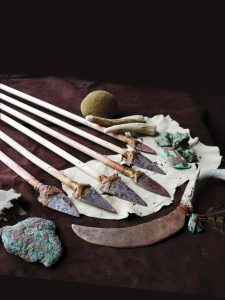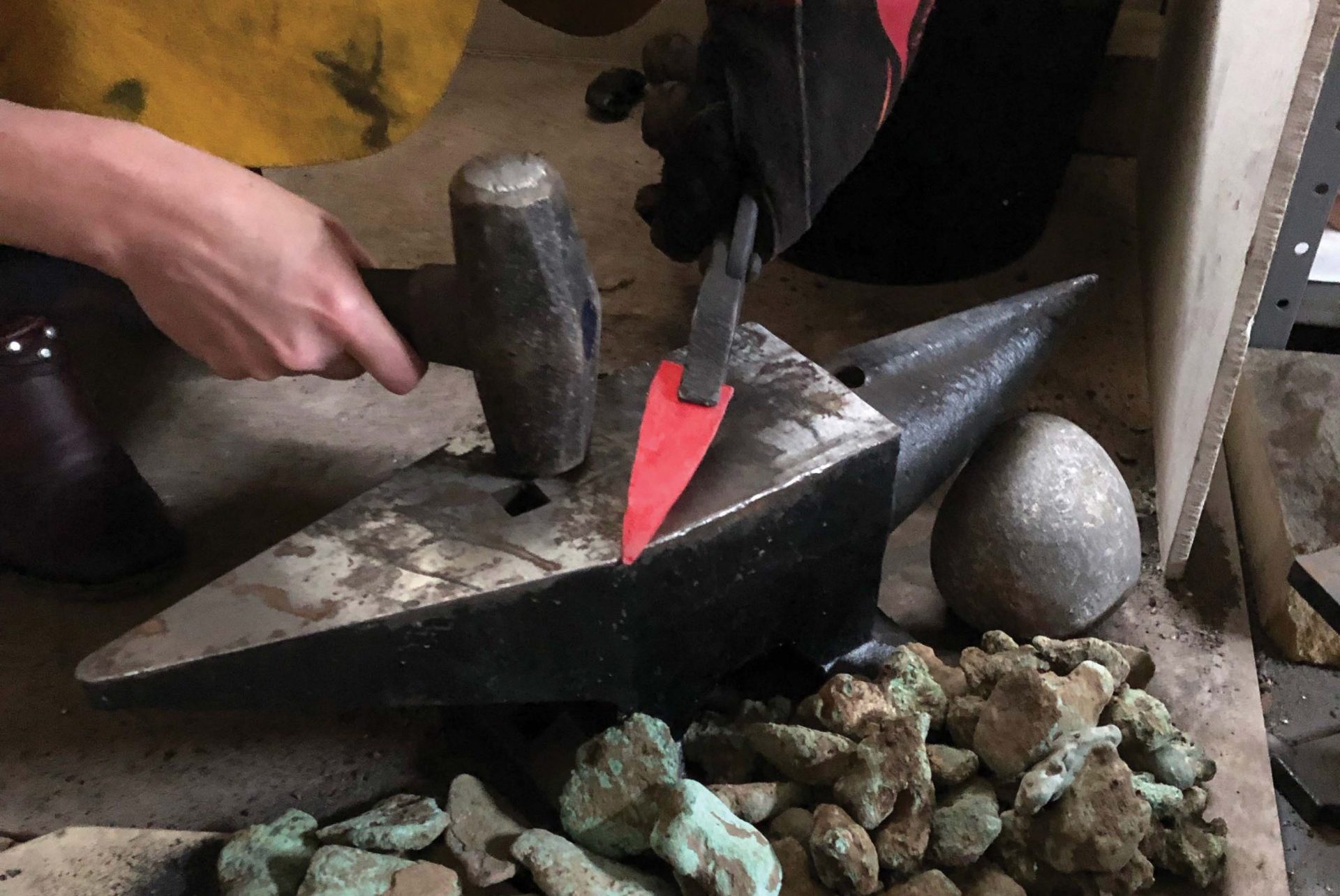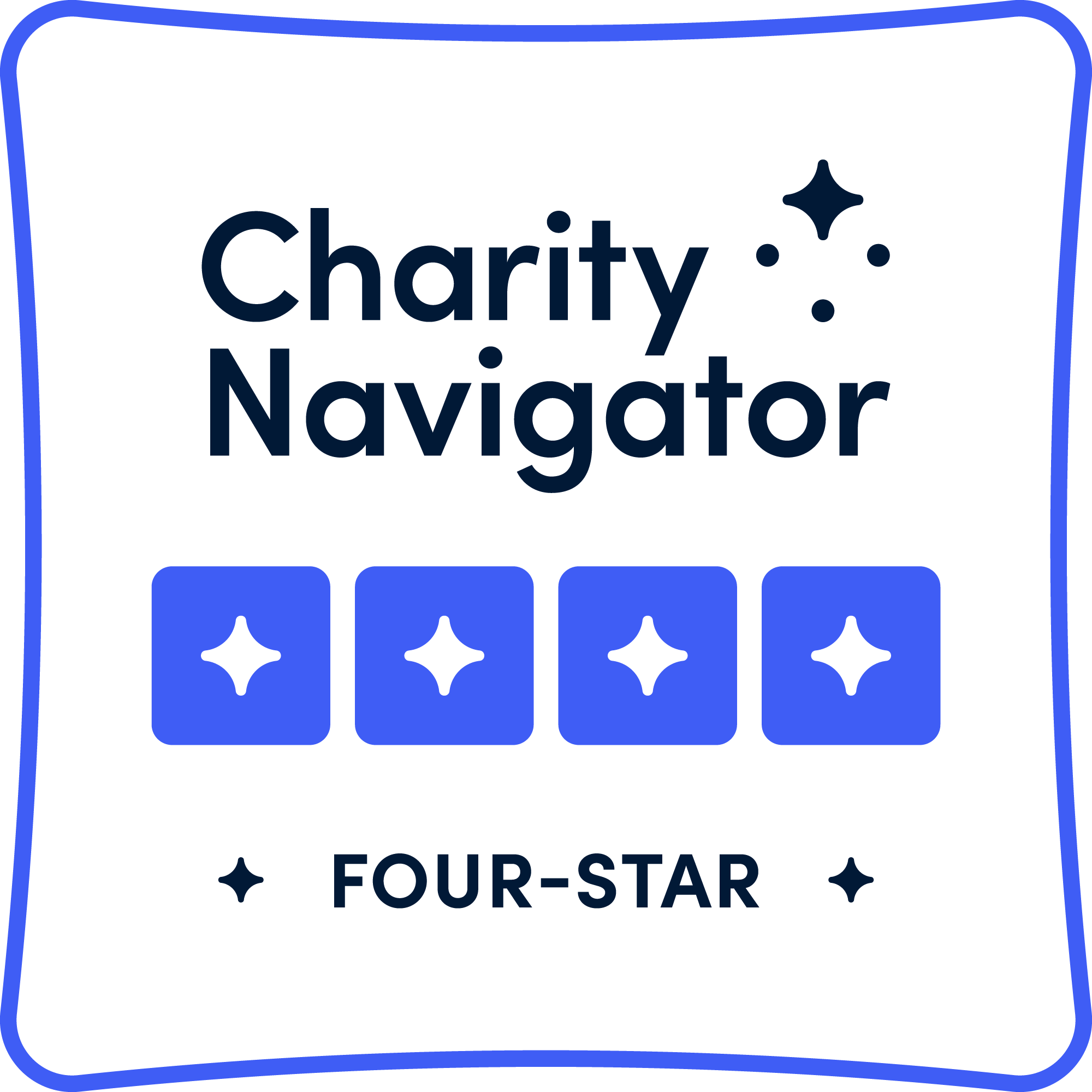By Tamara Jager Stewart

Replicas of copper projectile points and a curved knife were forged and hafted by Kent State University Professor of Archaeology Michelle Bebber using raw nuggets from the Upper Peninsula of Michigan as part of her research.
Photo: Michelle Rae Bebber / Kent State University
When large, well-made copper implements kept turning up in Midwestern fields and gardens in the early 20th century, some claimed they were proof that Bronze Age Europeans founded the great mound-building civilizations of the Americas, bringing Old World metallurgical skills with them. “Who else could have created such sophisticated metal tools?” the thinking went. Taking a closer look, however, researchers discovered that copper was mined in the Great Lakes region and crafted into tools by Indigenous groups, perhaps the mound-building Adena or Hopewell cultures of the Ohio River Basin. So, until the development of radiocarbon dating in the early 1950s, the Old Copper Complex (OCC)—also called Old Copper Culture—was thought to have occurred between around 1,000 B.C. and A.D. 500. Now studies show this enigmatic complex existed by at least 6,000 B.C., if not earlier, making it one of the oldest metallurgical traditions in the world.
The OCC is an Archaic period cultural phenomenon centered on the Upper Great Lakes region of North America and characterized by the creation and use of a wide variety of copper tools made by mining the area’s naturally occurring native copper deposits—the largest, purest copper on Earth. Around 10,000 years ago, these seasonally mobile hunting, fishing, and gathering groups made tools of stone, bone, and antler, with some small-scale use of copper. By 6,000 B.C., copper use had developed into a unifying tradition, with Archaic groups mining it to create their utilitarian objects, the only known complex to have developed copper metallurgy prior to becoming a settled, agriculturally based society.
The world’s largest concentration of native copper is in the western Great Lakes region, particularly Wisconsin and the Keweenaw Peninsula, the northernmost part of Michigan’s Upper Peninsula. Due to Pleistocene glacial activity, native copper was commonly found as small nuggets known as “float copper” dispersed across a vast region along the southern shores of Lake Superior and extending as far south as southern Illinois. Archaic period folks also mined lode deposits—large masses of copper near the surface—and fissure deposits, or narrow veins of copper that could extend deep underground.
…
Because Great Lakes copper is typically more than 95% pure, ancient groups were often able to simply pick up a nugget, break off any surrounding matrix material, and begin hammering it into the desired shape. Research has shown that Archaic period groups in the Great Lakes region used a variety of production methods to create copper implements such as hot and cold hammering and annealing. Tool types include arrowheads, spearpoints, needles, chisels, awls, axes, a wide variety of knives, fishing tools, and other implements. Some tools had tangs attached to a shaft or sockets to fit over a shaft and most show heavy use. Many copper artifacts show extreme uniformity and quality, indicating a high degree of technological specialization. Despite the thousands of copper artifacts held in museums and likely more in private collections, few Archaic Great Lakes habitation sites exist and even fewer have been systematically excavated, with most data coming from a handful of professionally excavated cemeteries—namely the Reigh, Osceola, and Oconto sites in Wisconsin, and the Riverside site in Michigan.
This is an excerpt of Copper Metallurgists of 8,000 Years Ago , in American Archaeology, Spring 2024, Vol. 29, and No. 1. Subscribe to read the full text.
FURTHER READING
- Milwaukee Public Museum, Old Copper Culture collection
- Optimal linear estimation (OLE) modeling supports Early Holocene (9000–8000 R.C.Y.B.P.) copper tool production in North America, Michelle R. Bebber and Alastair J. M. Key, American Antiquity (2022).
- The Role of Functional Efficiency in the Decline of North America’s Copper Culture (8000-3000 B.P.): An Experimental, Ecological, and Evolutionary Approach, Michelle R. Bebber, Journal of Archaeological Method & Theory (2021).
- Tracing Social Interaction: Perspectives on Archaic Copper Exchange from the Upper Great Lakes, Mark Hill, American Antiquity (2012).




